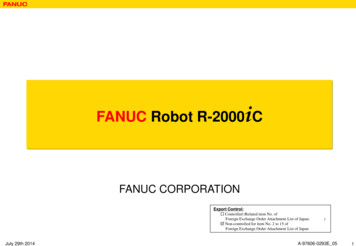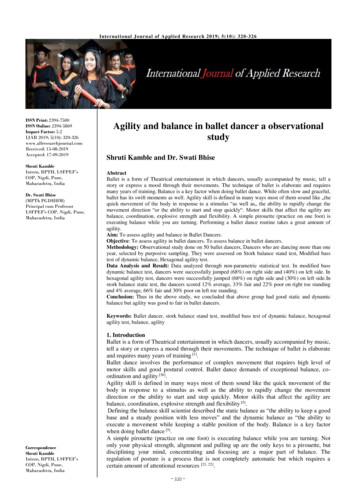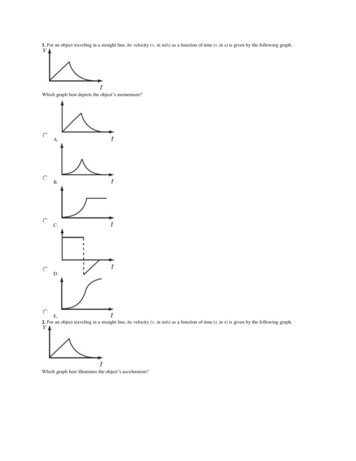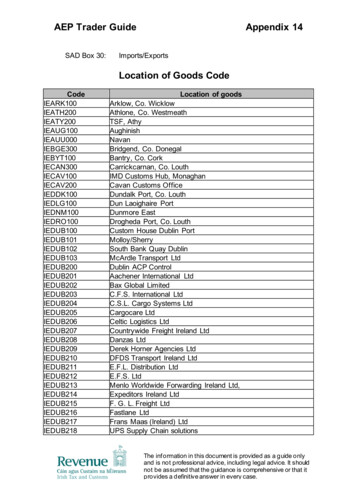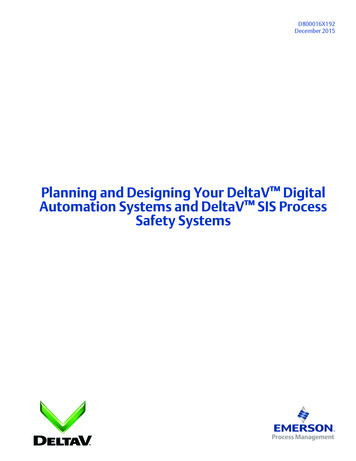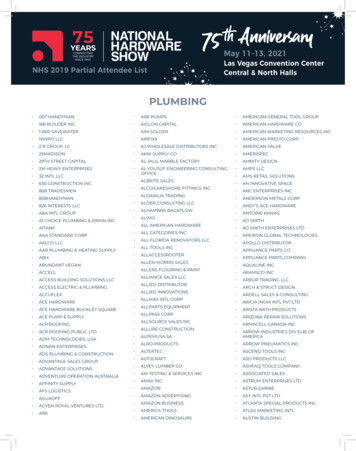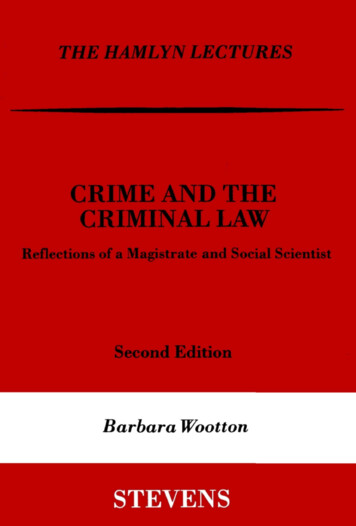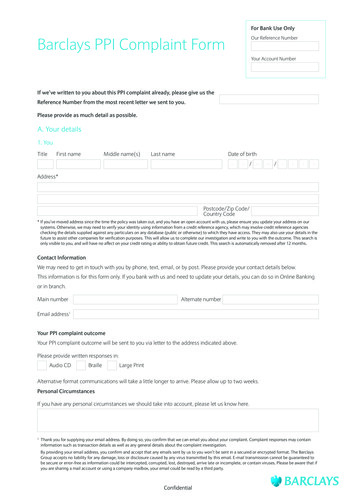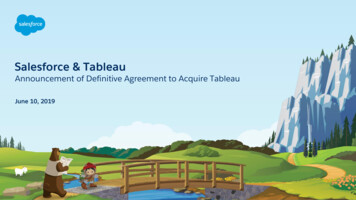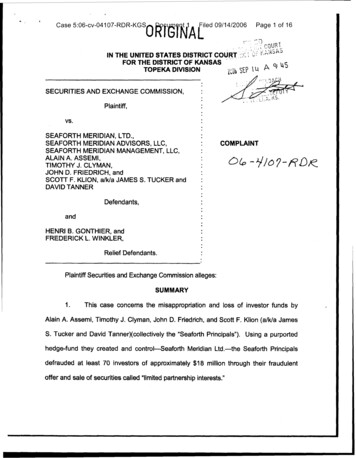
Transcription
-Case 5:06-cv-04107-RDR-KGS09/14/2006.-.Page 1 of 16,IN THE UNITED STATES DISTRICT COURT ::r, :FOR THE DISTRICT OF KANSASTOPEKA DIVISIONf;Jb SEP:i:*33ii'COUR!.--7u Aa; b5SECURITIES AND EXCHANGE COMMISSION,Plaintiff,VS.SEAFORTH MERIDIAN, LTD.,SEAFORTH MERIDIAN ADVISORS, LLC,SEAFORTH MERIDIAN MANAGEMENT, LLC,ALAlN A. ASSEMI,TIMOTHY J. CLYMAN,JOHN D. FRIEDRICH, andSCOTT F. KLION, a/Wa JAMES S. TUCKER andDAVID TANNERCOMPLAINT:Defendants,andHENRl B. GONTHIER, andFREDERICK L. W INKLER,Relief Defendants.--Plaintiff Securities and Exchange Commission alleges:SUMMARY1.This case concerns the misappropriation and loss of investor funds byAlain A. Assemi, Timothy J. Clyman, John D. Friedrich, and Scott F. Klion (alWa JamesS. Tucker and David Tanner)(collectively the "Seaforth Principals"). Using a purportedhedge-fund they created and control-seaforth Meridian Ltd.-theSeaforth Principalsdefrauded at least 70 investors of approximately 18 million through their fraudulentoffer and sale of securities called "limited partnership interests."
Case 5:06-cv-04107-RDR-KGS2.Document 1Filed 09/14/2006Page 2 of 16From at least May 2004 until October 2005, the Seaforth Principalsclaimed they could generate investor returns by a consenrative investment strategy andrelying on their own experience and expertise. In reality, the Seaforth Principals eithermisappropriated or cannot account for or explain the disappearance of approximately 13.5 million of investor funds sent offshore, at least 6 million going to a knownrecidivist fraudster. And the claims of expertise and experience omitted importantinformation. For example, Klion (who goes by "James Tucker" in this scheme), is also arecidivist fraudster previously enjoined by the Commission in 1999 for defrauding over1,400 victims of approximately 3 million.And Assemi, who recently moved toSwitzerland, was sued for securities fraud in 2004.3.While telling investors that their investment losses were the result of a "lackof liquidity" in their offshore investment strategy and other non-specific and implausibleexcuses, the persons responsible for the scheme, the Seaforth Principals, receivedundisclosed kickbacks totaling 600,000.4.The Seaforth Principals are responsible for numerous misrepresentationsand omissions of material fact concerning, among other things: (a) misappropriation anduse of investor funds; (b) the sufficiency of financial controls; (c) the risk of loss ofinvestor funds; (d) management's investment strategies and objectives; and (e)management's background, experience and financial expertise.5.In order to protect the public interest, the Commission seeks to stop thisfraudulent scheme and to preserve assets pending the final disposition of this litigation.The Commission therefore requests that the Court issue the following orders: 1) animmediate order that (i) freezes the remaining assets of the scheme, (ii) appoints aSEC v. Seaforth Meridian Ltd., et a/.COMPLAINTPage 2
-Case 5:06-cv-04107-RDR-KGSDocument 1Filed 09/14/2006Page 3 of 16temporary receiver, (iii) prohibits Defendants and Relief Defendants from destroyingrecords, and (iv) orders the repatriation of offshore funds; (2) injunctions against futureviolations of the specified federal securities laws; (3) disgorgement and prejudgmentinterest; (4) civil money penalties; and ( 5 ) any other equitable relief that the Court maydeem appropriate.JURlSlDlCTlON AND VENUE6.This Court has jurisdiction over this action pursuant to Section 22(a) of theSecurities Act of 1933 ("Securities Act") [15 U.S.C.5 77v(a)] andSecurities Exchange Act of 1934 ("Exchange Act") [I5 U.S.C.9Section 27 of the78aal. Defendants,directly and indirectly, made use of the mails and of the means and instrumentalities ofinterstate commerce in connection with the acts, practices, and courses of businessdescribed in this Complaint.7.Venue is proper because Seaforth Meridian filed regulatory and disclosuredocuments in Topeka, Kansas, relating to the sale of securities; and at least one initialSeaforth investor resided in Beattie, Kansas.RELATED PERSONS, ENTITIES, AND CIVIL CASESDefendants8.Seaforth Meridian Ltd. ("Seaforth Meridian") is a Florida limited partnershipcreated and controlled by the Seaforih Principals.9.Seaforth Meridian Manaaement, LLC. ("Seaforth Management") a Floridalimited liability company, is the "general partner" of Seaforth Meridian and managesSeaforth Meridian's operations and investments.10.Seaforth Meridian Advisors, LLC, ("Seaforth Advisors") a Florida limitedliability company, is Seaforth Meridian's investment adviser.SEC v. Seaforth Meridian Ltd., et a/.COMPLAINTPage 3
Case 5:06-cv-04107-RDR-KGS11.Document 1Filed 09/14/2006Page 4 of 16Assemi, age 39, previously of Concord, California, is the ManagingDirector of Seaforth Meridian and a managing general partner of Seaforth Managementand Seaforth Advisors. He is also a principal of Meriton, a purported Swiss investmentfund that received 6 million of Seaforth Meridian investor funds. In or about September2005, facing a civil suit for securities fraud in New York and an SEC contempt action inKansas, Assemi relocated to Walchilch, Switzerland.12.Clyman, age 51, a resident of Encinitas, California, is a managing memberof Seaforth Meridian, Seaforth Management, and Seaforth Advisors. Until May 2004, hewas a licensed securities broker.13.Friedrich, age 35, a resident of Far Rockaway, New York, is a managinggeneral partner of Seaforth Meridian, Seaforth Management, and Seaforth Advisors.Friedrich also previously held a license as a securities broker.14.Klion (a/k/a David Tanner and James S. Tucker) age 38, is a U.S. citizenand a resident of St. Maarten, Netherlands, Antilles. Using the Tucker alias, Klion is amanaging member of Seaforth Management and Seaforth Advisors and providedfinancing to start Seaforth Meridian. Klion was twice previously enjoined for securitiesfraud.Relief Defendants15.Henri B. Gonthier, age 58, a resident of Sarasota, Florida, manages a realestate firm and operates his own investment and consulting firm. Gonthier received atleast 41,000 in Seaforth Meridian investor funds for no apparent consideration.16.Frederich L. Winkler, age 64, a resident of Wellesley, Massachusetts, is ahotelier in Florida. Winkler received at least 29,000 in Seaforth Meridian investor fundsSEC v. Seaforth Meridian Ltd., et al.COMPLAINTPage 4
Case 5:06-cv-04107-RDR-KGSDocument 1Filed 09/14/2006Page 5 of 16for no apparent consideration.Other Relevant Entitles and Persons17.Quantum, a purported investment fund based in the United Kingdom,received approximately 7.5 million of Seaforth Meridian investors' funds. Quantum is notregistered with the Financial Services Authority ("FSA"), the financial services regulatorin the United Kingdom.18.Meriton, a purported investment fund based in Switzerland, receivedapproximately 6 million of Seaforth Meridian investors' funds.19.Raymond Coia, age 41, of the United Kingdom, is the principal of Quantum.On November 17,2003, the FSA permanently barred Coia from performing any functionrelated to a regulated activity.Coia is currently the subject of ongoing criminalproceedings in the UK.Related Cases Involving Seaforth Principals20.In SEC v. Tanner d/b/a Ca italEnhancement Club, et al., No. 05-4057-RDR (D. Kan. May 4, 2005)("CEC'), following tracing 9 million of defrauded investorfunds paid to Seaforth Meridian, the court-appointed receiver obtained a turnover orderagainst Seaforth Meridian. Seaforth paid approximately 4.1 million of the 9 millionowed and, as described below, offers a variety of contradictory and implausible excusesfor the inability to pay the balance. On August 21, 2006, in the CEC case, theCommission filed Plaintiff's Consolidated (1) Status Report and (2) Unopposed Motionfor Additional Time to Complete Settlement with Spencer Parties [Doc 2621, describingthe evidence supporting the fact that David Tanner is, in reality, recidivist fraudster ScottL. Klion.SEC v. Seaforth Meridian Ltd., et a/.COMPLAINTPage 5
Case 5:06-cv-04107-RDR-KGS21.Document 1Filed 09/14/2006Page 6 of 16In the pending case Dover Ltd., etal. v. A.B. Watlev, Inc., et al., No. 1:04-cv-07366-FM (S.D.N.Y. Sept. 15, 2004) an investor alleged Assemi defrauded her usingmaterial misrepresentations and omissions regarding a purported risk-free investmentyielding a return of 50% in approximately 4 months (150% per-year).22.In SEC v. Scott L. Wion, individuallv and d/b/a Cen-Tex Alchemy Guild et. a/,No. W98CA186 (W.D. Tex., June 3, 1998) the court enjoined Klion against futureviolations of the federal securities laws and ordered disgorgement and penalties after heperpetrated an international investment scheme and defrauded over 1,400 victims ofapproximately 3 million.STATEMENT OF FACTSGenesis of Seaforth Meridlan23.In or about May 2004, the Seaforth Principals retained an attorney toassist them in the formation of the three Seaforth entities and in the preparation of aPrivate Placement Memorandum ("PPM"), the primary offering document of SeaforthMeridian. Klion paid the attorney retainer and the PPM was prepared from informationprovided by the Seaforth Principals.24.The attorney engagement was also to include the preparation of monthlyreports for investors detailing report capital contributions and returns on investment. Anaccountant was supposed to monthly verify investors' contributions, returns, and profitor loss-all25.information to be provided by Seaforth Meridian,The basic transaction contemplated in the PPM was that SeaforthMeridian would utilize the investment experience and expertise of the SeaforthPrincipals to invest funds contributed by investors. For their efforts, the SeaforthPrincipals were to earn 55% of either "monthly net revenue" or "cumulative net incomeSEC v. Seaforth Meridian Ltd., et a/.COMPLAINTPage 6
--Case 506-cv-04107-RDR-KGS--Document 1- -Filed 09/14/2006Page 7 of 16over and above the aggregate of the previous calendar months' net income" dependingon which portion of the PPM one chooses to believe.Misrepresentations and Omissions26.Starting with Seaforth Meridian's inception in May 2004, and while raisinga substantial amount of investor funds, including 9 million from Klion's CEC scheme,the Seaforth Principals made repeated misrepresentations and omissions and actedcontrary to their own representations in the PPM.27.To appeal to investors who rely on a fixed income to generate monthlypayments for living expenses, the PPM stated that Seaforth Meridian employs astrategy intended to create an ongoing monthly cash revenue stream and that theprimary investment objective is "growth of capital and production of income." In reality,Seaforth Meridian sent approximately 13.5 million of a total of 18 million (75%) ofinvestor funds to Quantium ( 7.5 million) and Meriton ( 6 million), two suspect offshorefunds with no verifiable history of paying monthly returns, generating growth of capital,or production of income.28.To assure investors of the safety of the investment strategy, the PPMclaimed its "business" was "buying and selling 'A' rated or better fixed-income bonds aswell as trading securities of medium to large capitalized companies, including stocks,warrants, rights and options of U.S. and non-U.S. entities." It further claimed it would"concentrate the majority of its collective efforts upon fixed-income bond and instrumenttrading" and would "execute only issues that have a CUSlPllSlN number (a designationallowing for electronic quotation by brokers) and are listed on Bloomberg, Euroclear,andlor Clearstream (electronic quotation services). In reality, the Seaforth MeridianSEC v. Seaforth Meridian Ltd., et a/,COMPLAINTPage 7
Case 5:06-cv-04107-RDR-KGSDocument 1Filed 09/14/2006Page 8 of 16principals could not furnish any evidence that Quantum and Meriton purchased fixedincome bonds or legitimate recognized security, or that Quantum or Meriton have aCUSlPllSlN number or appear on an electronic quotation service.29.The PPM claims that the division of revenue (or income) would be 55% toSeaforth Management and 45% to the investors. In reality, Seaforth Meridian paid the"General Partner" (Seaforth Management) more than 600,000 and Quantum andMeriton paid Seaforth Management approximately 600,000 in undisclosed kickbacks.These payments are inconsistent with the claimed sharing of profits.And sinceQuantum and Meriton never demonstrated actual income or revenue from theirunspecified investment activity, payments to Seaforth Management or investors wereactually discretionary decisions not based on income or revenue as described in thePPM.30.The PPM further claimed the Seaforth Principals would undertake duediligence regarding the prospective investments, including obtaining prospectuses andfinancial statements. In reality, the only due diligence was that Assemi claims to havemade a 25,000 "sample test" investment in Quantum where the "profit was very nice"before committing approximately 7.5 million of investor funds.But any real andmeaningful due diligence would have shown that the person behind Quantum (Coia)was actually a recidivist fraudster permanently banned by the FSA. For Meriton ( 6million), Assemi purportedly relied on a 25,000 sample test and a letter of guaranteefrom an accountholder at Citibank. In reality, Seaforth Meridian's bank records show noevidence of a test investment with Quantum and the guarantee is worthless.31.Additional significant misrepresentations and omissions include:SEC v. Seaforth Meridian Ltd., eta/.COMPLAINTPage 8
-.-Case 5:06-cv-04107-RDR-KGS(a)- -Document 1Filed 09/14/2006Page 9 of 16While touting Tucker as having "banking and brokerage experiencein equity lending as well as establishing global entities for investmentmanagement purposes," the PPM failed to disclose that Tucker is really Klion,who in 1999 was sued by the Commission for defrauding over 1,400 victims ofapproximately 3 million.(b)The PPM further failed to disclose that Klion, this time using thealias David Tanner, was responsible for the CEC scheme which defraudedthousands of investors of more than 15 million.(c)A later version of the PPM, dated "August 2005," after the CECreceiver demanded the return of investor funds, conceals KlionTTucker'sinvolvement in the scheme by removing all references to him or his purportedexpertise.(d)The PPM states that Assemi, among others, was "not aware of anypast, present, or pending material litigation, threats of litigation or complaintsagainst [him]." In reality, Assemi was sued for investment fraud in New York onSeptember 15, 2004--a case that was ongoing at the time the PPM wasdistributed to investors.(e)The PPM omitted an important conflict of interest-that Assemi wasactually a managing director of Meriton.(f)The PPM touted the involvement of three Seaforth Principals(Assemi, Clyman, and Friedrich) in determining the strategies for investingSeaforth Meridian Funds and performing the necessary due diligence. In reality,SEC v. Seaforth Meridian Ltd., et a/.COMPLAINTPage 9
Case 5:06-cv-04107-RDR-KGSClyman and Friedrich-theDocument 1Filed 0911412006Page 10 of 16two former securities professionals-deferred toAssemi for critical decisions regarding the use of millions of investor proceeds.(g)The PPM omitted that two professionals--the attorney retained todraft the PPM and prepare monthly statements and the accountant hired to verifythis work and conduct an annual audit of Seaforth Meridian-werefired by theSeaforth principals in December 2004 after the professionals demandedverification of the legitimacy of the Quantum and Meriton investments.Lulling32.Throughout the offering period through late-2005, the Seaforth Principalssent to investors false and misleading monthly account statements and newslettersshowing supposed profits and emphasizing the safety of the investors' principal. Someinvestors received nominal payments represented as profits. But during this period, theSeaforth Principals had no financial basis for determining the assets or profits of SeaforthMeridian or individual investors. In late 2005, shortly after the 9 million turnover orderwas entered against Seaforth Meridian in the CEC case, the mailing of monthly accountstatements and newsletters stopped.33.On July 21, 2005, the CEC Receiver filed a motion relating to the tumoverof property against Seaforth Meridian and others. On November 22, 2005 the CECReceiver motion for Show Cause Order relating to Seaforth Meridian's failure to pay 4.9million of a 9 million tumover order.In their defense, Seaforth Meridian, Assemi,Clyman, and Friedrich presented contradictory, false and misleading information. Forexample, in one contempt-related affidavit filed on November 23, 2005, Clyman declaredthat "[olnce the Quantum Investment is liquidated, the remaining balance [ 4.9 million] . . .SEC v. Seaforth Meridian Ltd., et a/.COMPLAINTPage 10
---pp-pp--pCase 5:06-cv-04107-RDR-KGSDocument 1--Filed 09/14/2006-Page 11 of 16will be turned over." But five months later, on April 24, 2006, Friedrich declared that theywere "awaiting the transfer by Standard Charter Bank Tokyo of re-certified Bonds toNewbridge Securities . . . This will enable the Limited Partnership to redeem its 13.75 MUSD investment and pay the balance due." In reality, the money has yet to be turnedover and Newbridge Securities provided to the Commission information showing that atthe time of Friedrich's affidavit, Newbridge's clearing broker had already rejected thepurported exotic bond transaction contemplated by Seaforth Meridian.Investor Loss34.Of the original 18 million invested in Seaforth Meridian, 4.1 million waspaid to the CEC receiver, 1 15,556 was paid to Seaforth Meridian attorneys, and onlyapproximately 105,000 remains in bank and brokerage accounts today. The SeaforthMeridian principals still cannot or refuse to explain truthfully the disappearance of 13.5million sent to Quantum and Meriton.35.While refusing to pay investors or the CEC Receiver, a review of bankrecords, including some offshore accounts controlled by Quantum and Meriton, revealsthat the Seaforth Principals pocketed at least 600,000 in undisclosed kickbacks.SEC v. Seaforth Meridian Ltd., et a/.COMPLAINTPage 11
Case 5:06-cv-04107-RDR-KGSDocument 1Filed 09/14/2006Page 12 of 16FIRST CLAIMViolations of Section 17(a) of the Securities Act(Against All Defendants)36.Paragraphs 1 through 35 are realleged and incorporated by reference.37.Defendants, directly or indirectly, singly or in concert with others, in theoffer and sale of securities, by use of the means and instruments of transportation andcommunication in interstate commerce and by use of the mails, have: (a) employeddevices, schemes or artifices to defraud; (b) obtained money or property by means ofuntrue statements of material fact or omissions to state material facts necessary inorder to make the statements made, in light of the circumstances under which they weremade, not misleading; and (c) engaged in transactions, practices or courses of businesswhich operate or would operate as a fraud or deceit.38.As part of and in furtherance of their scheme, Defendants directly andindirectly, prepared, disseminated or used contracts, written offering documents,promotional materials, investor and other correspondence, and oral presentations,which contained untrue statements of material fact and which omitted to state materialfacts necessary in order to make the statements made, in light of the circumstancesunder which they were made, not misleading, including, but not limited to, thosestatements and omissions set forth in paragraphs 1 through 35 above.39.Defendants madetheabove-referenced misrepresentations andomissions knowingly or with recklessness regarding the truth. Defendants were alsonegligent in their actions regarding the representations and omissions alleged herein.SEC v. Seaforth Meridian Ltd., et a/.COMPLAINTPage 12 pag
Quantum is not registered with the Financial Services Authority ("FSA"), the financial services regulator in the United Kingdom. 18. Meriton, a purported investment fund based in Switzerland, received approximately 6 million of Seaforth Meridian investors' funds. 19. Raymond Coia, age 41, of the Unit

